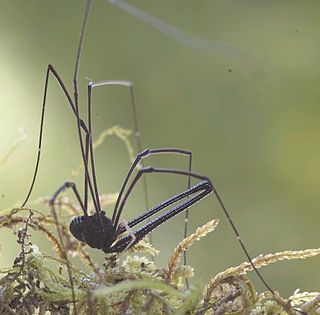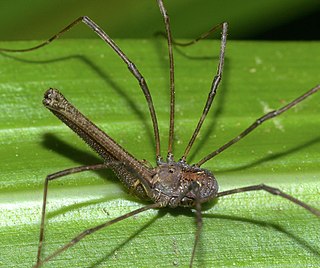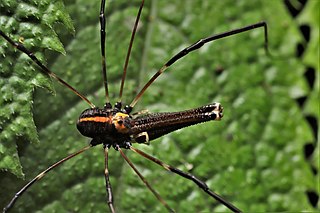
The Opiliones are an order of arachnids colloquially known as harvestmen, harvesters, or daddy longlegs. As of April 2017, over 6,650 species of harvestmen have been discovered worldwide, although the total number of extant species may exceed 10,000. The order Opiliones includes five suborders: Cyphophthalmi, Eupnoi, Dyspnoi, Laniatores, and Tetrophthalmi, which were named in 2014.

The New Zealand giraffe weevil, Lasiorhynchus barbicornis, is a distinctive straight-snouted weevil in the subfamily Brentinae, endemic to New Zealand. L. barbicornis is New Zealand's longest beetle, and shows extreme sexual dimorphism: males measure up to 90 mm, and females 50 mm, although there is an extreme range of body sizes in both sexes. In males the elongated snout can be nearly as long as the body. Male giraffe weevils use this long rostrum to battle over females, although small males can avoid conflict and 'sneak' in to mate with females, sometimes under the noses of large males. The larval weevils tunnel into wood for at least two years before emerging, and live for only a few weeks as adults.

Cyphophthalmi is a suborder of harvestmen, colloquially known as mite harvestmen. Cyphophthalmi comprises 36 genera, and more than two hundred described species. The six families are currently grouped into three infraorders: the Boreophthalmi, Scopulophthalmi, and Sternophthalmi.

The Monoscutidae are a family of harvestmen with 32 known species that all occur in or near Australia and New Zealand.

The Pettalidae are a family of harvestmen with 75 described species in 10 genera. Several undescribed species are known or assumed in some genera.

Nipponopsalididae is a family of harvestmen with three described species in one genus, Nipponopsalis, which is found in East Asia.

Ischyropsalididae is a family of harvestmen with 31 described species in 3 genera, found in Europe and North America.

Cambridgea is a spider genus in the family Desidae and some of the first endemic spiders described from New Zealand. They are known for constructing large horizontal sheet webs measuring up to a square metre in larger species. Cambridgea were originally assigned to the Agelenidae by Dalmas in 1917 but were reassigned to the Stiphidiidae in 1973. Most recently, both Cambridgea and sister genus Nanocambridgea were reassigned to the Desidae, subfamily Porteriinae on the basis of molecular evidence.
Gonzalo Giribet is a Spanish-American invertebrate zoologist and Alexander Agassiz Professor of zoology working on systematics and biogeography at the Museum of Comparative Zoology in Harvard University. He is a past president of the International Society for Invertebrate Morphology, of the Willi Hennig Society, and vice-president of the Sociedad Española de Malacología.

Texella is a genus of armoured harvestmen in the family Phalangodidae. There are more than 20 described species in Texella.
Enigmina is a genus of armoured harvestmen in the family Phalangodidae. There are at least two described species in Enigmina.
Crosbyella is a genus of armoured harvestmen in the family Phalangodidae. There are about five described species in Crosbyella.
Megacina is a genus of armoured harvestmen in the family Phalangodidae. There are at least four described species in Megacina.

Cambridgea foliata is a species of Desidae spider endemic to New Zealand. These nocturnal, arboreal spiders are distributed throughout the North Island of New Zealand and build large horizontal sheet-webs with a large number of knock-down threads.

Briggsus is a genus of armoured harvestmen in the family Cladonychiidae. There are about five described species in Briggsus, found in the coastal forests of Oregon and Washington.

Pantopsalis is a genus of eleven species of harvestman in the family Neopilionidae. They are all endemic to New Zealand. Males of some species are notable for their enlarged chelicerae.

Pantopsalis cheliferoides is a species of Neopilionid harvestmen. This species was originally described by William Colenso and is endemic to New Zealand.

Pantopsalis albipalpis is a species of harvestman in the genus Pantopsalis. It was first described by Reginald Innes Pocock in a paper published in 1902. P. albipalpis cannot be distinguished from P. johnsi but P. johnsi has not been synonymised as these species each have a distinct distribution.

Pantopsalis listeri is a species of harvestman in the family Neopilionidae.

Forsteropsalis pureora is a species of long-legged harvestman in the family Neopilionidae. This species is endemic to New Zealand, found in the North Island. They are found in native forest, often resting on vegetation or stream banks.














